Figures
Figures 1 and 2. Stone tools in-situ (Feb. 13, 2019).
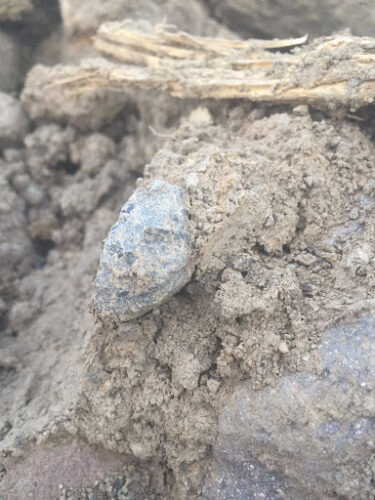
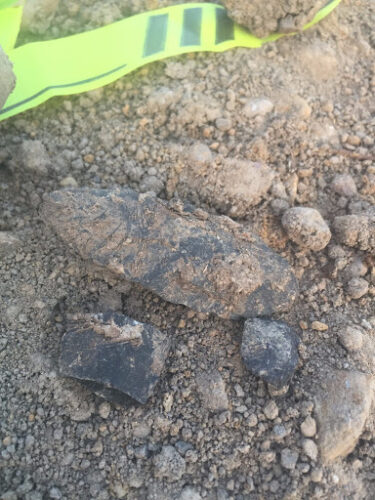
Figure 3. Disturbed soil at worksite; cleared of forest and Unist’ot’en trapline (Feb. 13, 2019).
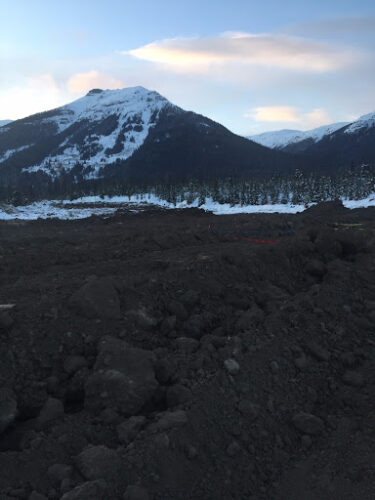
Figure 4. Biface recovered from worksite (Feb. 13, 2019).
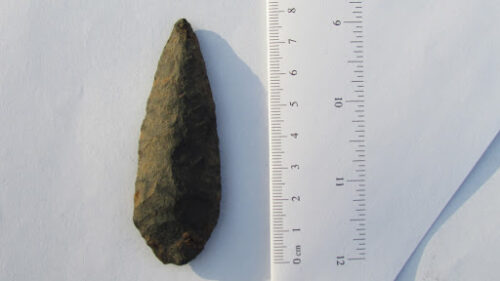
Figure 5. Fragment of stemmed point recovered from worksite (Feb. 13, 2019).
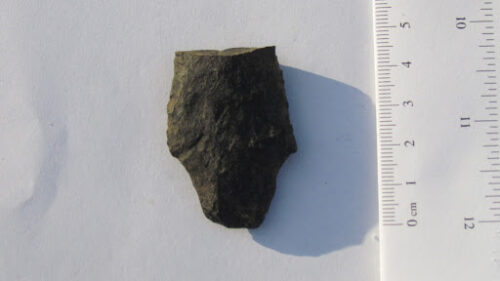
On February 13, 2019, multiple artifacts were recovered from the bulldozed portions of Coastal GasLink Pipeline Ltd. (CGL) construction site in Ya’tsalkas (Dark House) Talbits Kwah yintah (territory) of the Wet’suwet’en near Houston in northwestern British Columbia. The recovery of artifacts from disturbed ground at the construction site indicates that the Heritage Conservation Act of British Columbia (HCA, RSBC 1996) and its accompanying guidelines have failed Indigenous communities in British Columbia once again.
Consideration of cultural heritage resources is mandated in British Columbia to:
“…encourage and facilitate the protection and conservation of heritage property in British Columbia.” (HCA Part 1, Section 1)
The HCA legal framework is further grounded by the Forest Act (RSBC 1996), where a cultural heritage resource is defined as:
“…an object, a site or the location of a traditional societal practice that is of historical, cultural or archaeological significance to British Columbia, a community or an aboriginal people.” (Forest Act, Section 1 [1])
The Unist’ot’en have permanently reoccupied their territory since 2009. The proposed CGL work camp is on Unist’ot’en territory and at the confluence of three river systems, the Gosnell Valley bottom tributary in particular, is one of the largest in the Skeena Watershed and produces substantial coho salmon runs (Oncorhynchus kisutch) (Gottesfeld and Rabnett 2008). The main Gosnell trail (trade and war trail) is subsumed by the Shea Creek Forest Service Road, which accesses Unist’ot’en and bisects the CGL work camp and other ancillary CGL developments (Rabnett 2001). Dozens of heritage and archaeological sites are recorded at the confluence of the three river systems (Weathers 2006; Office of the Wet’suwet’en 2010). Rich oral traditions (histories and stories) highlight the Morice River area as a major travel corridor between the Interior and the Coast and as home to Wet’suwet’en people for millennia (Daly 2005).
In October 2018, CGL was given the green light to begin construction on a 670 km pipeline, various compressor stations, and work camps in northwestern British Columbia. No consent for pipeline construction has been obtained from the Dinï ze’ and Ts’akë ze’ (Wet’suwet’en Hereditary chiefs). A significant portion of the pipeline and a work camp were proposed on Talbits Kwah yintah, where no archaeological inventory/impact assessment (AIA) was conducted.
In 2013, under permit 2013-0004, CGL consultant archaeologists described the entire Morice River area (which runs through Talbits Kwah yintah) as having “high potential” for cultural heritage resources (5-9 of the 2013-0004 report). Yet, when archaeologists were not granted access to the territory by the Hereditary Chiefs (whose decisions were enforced by Unist’ot’en), the permit was closed.
A new permit was opened (2013-0033) and CGL consultant archaeologists reversed the findings of the original overview assessment stating that the proposed development area in Talbits Kwah (known as Multi Use Site 9A, Camp 9A, CGL work camp) now had low archaeological potential. In consulting contexts, the change in designation from “high” to “low” potential is highly irregular.
Furthermore, the CGL consultant archaeologists claim that the new low potential designation was the result of 1) “the moderately steeply sloping terrain…lack of microtopographical variation…logging activities…impacts from pine beetle”, and 2) a lack of archaeological sites within 2000 m of the CGL work camp. To the first point, logging activity and pine beetle infestation only lower the potential of locating culturally modified trees (CMTs), other types of archaeological features and artifacts often remain intact. Furthermore, camp volunteers and spokesperson Freda Huson assert that the claim in the AOA that the site lacks “microtopographical variation” is objectively false.
To the second point, previous cultural heritage investigations in the proposed development area reveal extensive and concentrated use in the past (Rabnett 2001; Trustler et al. 2002; Whaggus n.d.). Indeed stone tool artifacts were recovered from the CGL worksite on February 13, 2019 by camp volunteers and are estimated to be from the Shuswap Horizon (3500–2400 BP). Two artifacts were photographed in situ (see below), and removed from the construction site for fear of destruction. Other artifacts and fragments were left on site.
Cultural resources such as trails, villages, artifacts, and food resources on the Talbits Kwah yintah are intimately tied to Wet’suwet’en identity and cultural practice and are part of the larger Wet’suwet’en cultural heritage infrastructure. Wet’suwet’en cultural resources associate to landscape, placenames, stories, language, and identity, and their destruction leads to dispossession, disenfranchisement, and further colonial distress. The education value of cultural heritage resources in this area is high given that Unist’ot’en territory has been a site of land based education for Unist’ot’en and Wet’suwet’en members returning to the land to live and heal for over a decade. The work of the healing center continues to draw on the ancestral knowledge embedded in the land to help community members connect to their cultural heritage, inheritance, and unextinguished Wet’suwet’en law.
Furthermore, the Wet’suwet’en cultural heritage resources located in Talbits Kwa yintah inform both Canada and BC laws, and Wet’suwet’en law. Cultural heritage denotes use and occupation, which in turn determines Aboriginal Rights including Title. This cultural heritage singularly and as aggregate is a significant component of Wet’suwet’en law with linkages to access, use, trespass if any, and reparations where appropriate (Budhwa 2005).
We, the undersigned condemn the approval of a permit that reversed the initial valuation of archaeological potential (from high to low) because of a political conflict. Furthermore, we charge that the newly found artifacts reveal that archaeological heritage is clearly present, and that adjacent areas in the claimed for CGL development area should be evaluated as high potential and AIAs conducted in consultation with Ya’tsalkas (Dark House).
We, the undersigned request a review of the archaeological overview assessments and all archaeological permits granted to CGL in Wet’suwet’en territory, and that all construction and vehicle activity cease in Talbits Kwa yintah until these legal concerns for cultural heritage are met.
If you would like to sign please email: tsewedielh@gmail.com
In the subject line indicate: Open Letter to Arch Branch
In the body of the email include your full name, title(s), and affiliation(s)
Signatories:
Freda Huson, Spokesperson, Dark House- Unist’ot’en
Chelsey Geralda Armstrong, PhD
National Museum of Natural History, Smithsonian Institution
Michael Deal, PhD
President, Canadian Archaeological Association
Michael Blake, PhD
Professor and Chair, Anthropology, University of British Columbia
Andrew Martindale, PhD
Associate Professor of Anthropology, University of British Columbia
Neal Ferris, PhD
Professor and Lawson Chair of Canadian Archaeology, University of Western Ontario
Dana Lepofsky, PhD
Professor of Archaeology, Simon Fraser University
Charles R. Menzies, PhD
Professor of Anthropology, University of British Columbia
Gitxaała Nation
Antonia Mills, PhD
Professor Emerita, First Nations Studies
University of Northern British Columbia
Rudy Reimer / Yumks, PhD
Associate Professor of Archaeology and First Nations Studies, Simon Fraser University
Director, Bill Reid Centre, Indigenous Research Institute, Simon Fraser University
Squamish Nation
A. Catherine D’Andrea, PhD
Professor of Archaeology, Simon Fraser University
Jessica Metcalfe, PhD
Research Associate, Dept of Anthropology, University of British Columbia
James Conolly, PhD
Professor and Chair, Anthropology, Trent University
Ross W. Jamieson, PhD
Associate Professor of Archaeology, Simon Fraser University
Peter Johansen, PhD
Assistant Professor, Department of Anthropology, McGill University
Sue Rowley, PhD
Associate Professor of Anthropology, University of British Columbia
Curator, Museum of Anthropology
Kisha Supernant, PhD
Associate Director, Institute of Prairie Archaeology
Associate Professor, Department of Anthropology, University of Alberta
Métis Nation of Alberta
Sean Connaughton, PhD, RPA, RPCA
Consultant Archaeologist
Bill Angelbeck, PhD
Department of Anthropology and Sociology, Douglas College
Chris Arnett, PhD
Honourary Research Associate, Department of Anthropology, University of British Columbia
Patrick Morgan Ritchie, MA
Sts’ailes First Nation Heritage Research Archaeologist
Spencer Greening, PhD Student
Department of Archaeology, Simon Fraser University
Gitga’at First Nation
Pierre Elliott Trudeau Foundation Scholar
Anne Spice, MA, PhD Candidate
Department of Anthropology, City University of New York Graduate Center
Tlingit- Kwanlin Dun First Nation
Bryn Letham, PhD
Postdoctoral Fellow, Department of Archaeology, Simon Fraser University
Lesley R. Howse, PhD
Instructor, Archaeology and Heritage Studies, Wilfred Laurier University
Research Associate, Archaeology Centre, University of Toronto
Jacob Kinze Earnshaw, MA
BC Archaeological Consultant
Jon Sheppard, BA Hons.
Field Director / Permit Holder — Independent Archaeological Consultant
Jacob Salmen-Hartley, MA
BC Archaeological Consultant
Callum Abbott, MA
BC Archaeological Consultant, Independent
Ginevra Toniello, MA
Archaeology & Cultural Heritage Program Manager
Treaty, Lands & Resources Department, Tsleil-Waututh Nation
Kristen Bos, PhD Candidate
Department of Anthropology, University of Toronto
Cynthia Fowler, PhD
Professor and Chair, Sociology and Anthropology Department, Wofford College
President, Society of Ethnobiology
Crystal Migwans, MA, MPhil
Doctoral Candidate, Art History, Columbia University / Anishinaabe of Wiikwemkoong Unceded Territory
Kurt A. Jordan, PhD
Associate Professor of Anthropology and American Indian and Indigenous Studies, Cornell University
Director, Cornell Institute of Archaeology and Material Studies (CIAMS)
Willeke Wendrich, PhD
Director Cotsen Institute of Archaeology at UCLA
Joan Silsbee Chair of African Cultural Archaeology
Professor of Egyptian Archaeology and Digital Humanities
Alex C. McAlvay, PhD
Postdoctoral Research Associate, Ecology and Evolutionary Biology, Cornell University
Devin Rachar
Former BC Archaeological Consultant
Kristen Simmons, PhD candidate
Department of Anthropology, University of Chicago
David Finch, MES
Heritage Consultant, Yellowknife, NWT
Sandra Teresa Hyde, PhD, MPH
Anthropology Associate Professor & Undergraduate Program Chair, McGill; Associate Fellow Social Studies of Medicine, East Asian Studies, Institute for Studies in International Development
Kristin Norget, PhD
Associate Professor, Anthropology
McGill University
Megan Taylor Hicks, MA, MPhil
City University of New York (Graduate Center) and Hunter College
Michelle Murphy, PhD
Professor of History and WGSI, University of Toronto
Samantha Walker, PhD (ABD)
McGill University
Adam Fleischmann, PhD (ABD)
Department of Anthropology, McGill University
Diana Allan, PhD
Assistant Professor Department of Anthropology & Institute for the Study of International Development
McGill University
Paulette Steeves
Cree-Metis Archaeologist. Algoma University Faculty History.
Nominee Canada Research Chair Tier II Healing and Reconciliation
Seonaid Duffield, MA
Archaeological Consultant
Diana K. Moreiras Reynaga, MA
PhD Candidate in Archaeology/Bioarchaeology, The University of Western Ontario
Brian Noble, PhD
Associate Professor Department of Sociology & Social Anthropology
Dalhousie University
Darcy Mathews, PhD
Assistant Professor, University of Victoria
Joanne Hammond
Archaeologist and Assistant CEO, Skeetchestn Natural Resources Corp, Skeetchestn, BC
Sara Wickham, MSc, PhD Student
School of Environment, Resources and Sustainability, University of Waterloo
Kyle Forsythe, MA
PhD Candidate, Department of Anthropology, McGill University
Steven Mozarowski, BsC
Archaeologist
Robert Muckle
Archaeologist, Capilano University
Ian Sellers
Archaeologist
Dr. Scott Hamilton
Professor and Chair, Dept of Anthropology, Lakehead University
April M. Beisaw, PhD, RPA
Associate Professor of Anthropology, Vassar College
Stephanie Halmhofer, MA,
BC archaeological consultant.
Alessandria Testani, MA Candidate
Department of Archaeology, Simon Fraser University
Consultant Archaeologist
Kait Kenel, MA Candidate
Department of Archaeology and Anthropology, University of Saskatchewan
Samantha Markham, MES
Consultant Archaeologist
Natalie Owl, PhD Candidate
University of Regina
Judith G. Anderson
Edna, CA
Sage Vanier, BA
Anthropology, University of British Columbia
Alexandra Chalier
Undergraduate visual arts student, University of British Columbia
Rachel Hoole
Undergraduate Student, McGill University
Denzel Sutherland-Wilson
Unist’ot’en land defender. BA Anthropology, McGill University.
House of Tsi’basa, Gisghaast clan, Gitxsan Nation
Eréndira M. Quintana Morales, PhD
Postdoctoral Scholar, Department of Anthropology, Penn State University
Indigenous Student Alliance
McGill University
References
Budhwa, R. 2005. An Alternate Model for First Nations Involvement in Resource Management Archaeology. Canadian Journal of Archaeology/Journal Canadien d’Archéologie29(1):20–45.
Daly, R. 2005. Our Box was Full: An Ethnography for the Delgamuukw Plaintiffs. UBC Press.
Gottesfeld, A., and K.A. Rabnett. 2008. Skeena River Fish and their Habitat. Ecotrust, Vancouver.
Office of the Wet’suwet’en. 2010. Wedzin Kwa/ Morice Lake Cultural Heritage Resource Preliminary Field ASsessment. Prepared for Office of the Wet’suwet’en, Smithers B.C.
Rabnett, K., (Suskwa Research). 2001. Selected Wet’suwet’en Cultural Heritage Within Portions of Morice Landscape Unit Planning Areas, Morice Forest District. Report prepared for Office of the Wet’suwet’en, Smithers B.C.
Trustler, S., G. Andrew, S. Schug, K. Rabnett, F. Depey. 2002. Wet’suwet’en Territorial Stewardship Plan. FRBC Final Report 2001/2002. [Office of the Wet’suwet’en, Smithers B.C.?]
Whaggus, n.d. Wet’suwet’en Use Study (WUS) for the Proposed KSL Looping Project. Report prepared by WHAAGUS Applied Ethnography and Research Consulting Services and the Office of the Wet’suwet’en. [Office of the Wet’suwet’en, Smithers B.C.?]
Weathers, B. 2006. British Columbia Archaeological Inventory and Impact Assessment Interim Report (2006-173). Enbridge Gateway Project: Target Area 48 Ancillary Campsite 12. Ministry of Forests, Lands and Natural Resource Operations, Archaeology Branch, Victoria, B.C.


